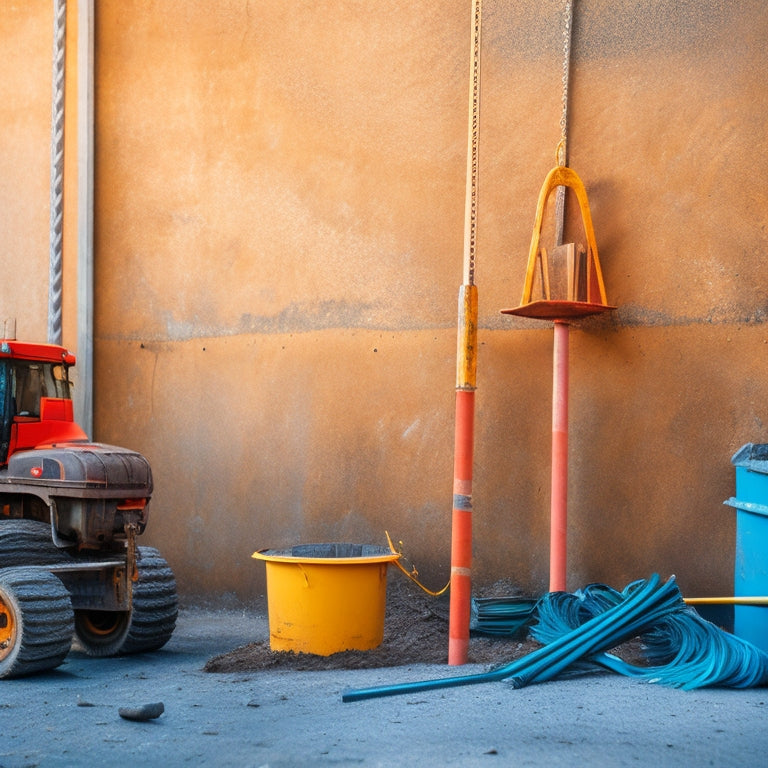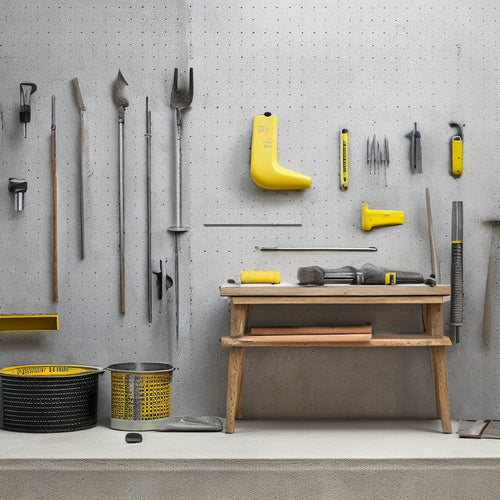
Top 3 Tools for Reinforcing Concrete Walls
Share
You'll need a combination of three essential tools to effectively reinforce your concrete walls: horizontal joint reinforcement, vertical reinforcement, and advanced anchoring systems, each of which plays a critical role in preventing cracking, resisting lateral loads, and ensuring the overall durability of your structure. Horizontal joint reinforcement prevents cracking, while vertical reinforcement provides lateral load resistance. Advanced anchoring systems, like mechanical and chemical anchoring, secure your walls. By understanding how to implement these tools, you'll be able to create a robust and long-lasting concrete wall that can withstand various environmental and structural stresses, and uncover the nuances of each approach can further optimize your wall's performance.
Key Takeaways
• Incorporate horizontal joint reinforcement, such as rebar or fiber mesh, to prevent cracking in concrete walls.
• Utilize steel fibers to enhance concrete walls' durability and resistance to cracking, choosing from hooked-end, crimped, or straight fibers.
• Implement mechanical or chemical anchoring systems, combining with post-tensioning for robust wall performance.
• Select reinforcement materials based on corrosion resistance and durability, adhering to local building codes and manufacturer guidelines.
• Use advanced anchoring systems, such as composite reinforcement materials (fiber-reinforced polymers), for added strength and wall stability.
Essential Reinforcement for Cinder Blocks
When building with cinder blocks, you must incorporate vital reinforcement to prevent cracking and guarantee structural integrity, as these blocks tend to be more porous and prone to water damage than other masonry materials. There are several types of cinder blocks, including solid, hollow, and insulated blocks, each requiring specific reinforcement techniques.
You'll need to use horizontal joint reinforcement, such as rebar or fiber mesh, to prevent cracking and improve tensile strength. Vertical reinforcement, like rebar or anchor bolts, is also necessary to resist lateral loads and guarantee the wall's stability. Additionally, you should use a drainage system to prevent water accumulation and reduce the risk of damage.
When selecting reinforcement materials, consider factors like corrosion resistance, durability, and compatibility with the cinder blocks. It's also vital to follow local building codes and regulations, as well as manufacturer guidelines for specific products.
Strengthening Walls With Steel Fibers
You can strengthen your concrete walls by incorporating steel fibers, which provide exceptional durability and resistance to cracking and shrinkage. These fibers are available in various types, including hooked-end, crimped, and straight fibers, each with its unique benefits.
Hooked-end fibers, for instance, offer improved anchorage, while crimped fibers provide enhanced bonding with the concrete matrix.
When it comes to application methods, you have several options to choose from. One common approach is to mix the fibers directly into the concrete during the batching process. This guarantees uniform distribution throughout the wall.
Alternatively, you can apply the fibers as a shotcrete or gunite mixture, which is particularly useful for retrofitting existing walls. Regardless of the method you choose, it's crucial to follow the manufacturer's guidelines for fiber dosage and mixing procedures to achieve the best results.
Advanced Anchoring Systems for Walls
Two primary types of advanced anchoring systems, mechanical and chemical, are available to securely tie your concrete walls to the surrounding structure or foundation.
Mechanical anchoring systems use metallic components, such as anchors or bolts, to create a physical bond between the wall and the surrounding structure. These systems are often used in new construction projects and can be installed during the initial building phase.
Chemical anchoring systems, on the other hand, use adhesives to bond the anchor to the concrete. This type of system is ideal for retrofitting existing structures, as it doesn't require significant modifications to the surrounding structure.
When combining advanced anchoring systems with post-tensioning techniques, you can create a robust and durable concrete wall that can withstand significant loads.
Additionally, using composite reinforcement materials, such as fiber-reinforced polymers, can further enhance the strength and stability of your walls.
Frequently Asked Questions
Can I Use Reinforcement Tools for Walls With Existing Cracks?
When dealing with walls that already have cracks, you'll need to prioritize crack repair before using reinforcement tools.
This is vital for wall stability, as ignoring cracks can lead to further damage.
You'll want to assess the severity of the cracks and apply the appropriate repair method before proceeding with reinforcement.
Do I Need Special Training to Install Anchoring Systems?
You're about to commence a monumental task: installing anchoring systems! It's not a cakewalk, but with the right approach, you'll be a pro in no time.
Here's the deal: you'll need to brush up on specialized installation techniques to guarantee a secure hold. Don't worry, it's not rocket science, but some training is required.
You'll need to understand the nuances of anchoring systems, and that's where training requirements come in. Get ready to geek out on the specifics, and you'll be anchoring like a champ in no time!
Are Steel Fibers Suitable for Walls Exposed to Seawater?
When you're building walls exposed to seawater, you're right to question if steel fibers are suitable.
Unfortunately, they're not the best choice due to their limited corrosion resistance.
You'll need to conduct a thorough durability assessment to guarantee the reinforcement material can withstand the harsh marine environment.
In this case, alternative materials with higher corrosion resistance, such as fiber-reinforced polymers or stainless steel, might be a better fit for your project.
Can I Reuse Reinforcement Tools for Multiple Projects?
When it comes to reusing reinforcement tools for multiple projects, you'll want to take into account the long-term costs and benefits.
Recycling tools can greatly boost project efficiency, but only if you maintain and clean them properly.
Make certain to inspect each tool for damage or wear before reusing it, and always follow the manufacturer's guidelines.
Do Local Building Codes Regulate Concrete Wall Reinforcement Tools?
You're maneuvering a complex puzzle, and understanding local building codes is an essential piece.
When it comes to concrete wall reinforcement tools, you're not free to improvise. Local building regulations dictate the reinforcement standards you must follow, ensuring your structure can withstand the test of time and natural disasters.
You'll need to consult your local authorities to determine the specific requirements for your project, as they vary by region.
Conclusion
As you wrap up your concrete wall project, remember that reinforcing walls is like building a strong backbone - it's the foundation of a sturdy structure.
With the top 3 tools - essential cinder block reinforcement, steel fibers, and advanced anchoring systems - you'll be fortifying your walls like a pro.
Like a master puzzle, each piece fits together to create a solid, unshakeable whole.
Related Posts
-

10 Must-Have Tools for Concrete Repair Organization
You'll need a solid organization system to keep your concrete repair tools and materials within easy reach, protected...
-

Essential Tools for Epoxy Concrete Floor Repair
You'll need a thorough arsenal of specialized tools to guarantee a successful epoxy concrete floor repair. Floor prep...
-

What Tools Are Needed for Concrete Wall Foundations
You'll need a thorough array of tools and equipment to construct a concrete wall foundation that meets structural int...


